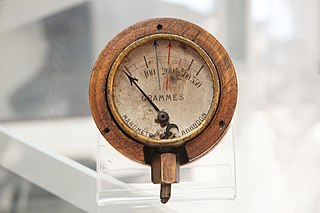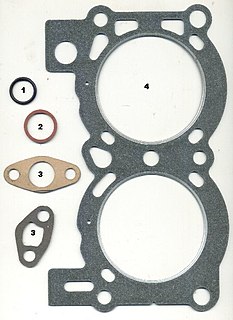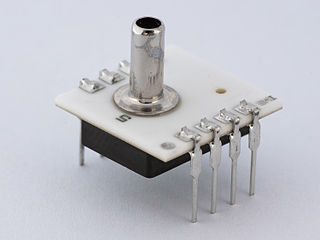
Pressure measurement is the analysis of an applied force by a fluid on a surface. Pressure is typically measured in units of force per unit of surface area. Many techniques have been developed for the measurement of pressure and vacuum. Instruments used to measure and display pressure in an integral unit are called pressure gauges or vacuum gauges. A manometer is a good example, as it uses a column of liquid to both measure and indicate pressure. Likewise the widely used Bourdon gauge is a mechanical device, which both measures and indicates and is probably the best known type of gauge.
A fire hose is a high-pressure hose that carries water or other fire retardant to a fire to extinguish it. Outdoors, it attaches either to a fire engine or a fire hydrant. Indoors, it can permanently attach to a building's standpipe or plumbing system.

Pneumatics is a branch of engineering that makes use of gas or pressurized air.

A gasket is a mechanical seal which fills the space between two or more mating surfaces, generally to prevent leakage from or into the joined objects while under compression.

A check valve, clack valve, non-return valve, reflux valve, retention valve or one-way valve is a valve that normally allows fluid to flow through it in only one direction.

An O-ring, also known as a packing, or a toric joint, is a mechanical gasket in the shape of a torus; it is a loop of elastomer with a round cross-section, designed to be seated in a groove and compressed during assembly between two or more parts, creating a seal at the interface.

A hose is a flexible hollow tube designed to carry fluids from one location to another. Hoses are also sometimes called pipes, or more generally tubing. The shape of a hose is usually cylindrical.

A solenoid valve is an electromechanical device in which the solenoid uses an electric current to generate a magnetic field and thereby operate a mechanism which regulates the opening of fluid flow in a valve.
Metal rubber is a broad, informal name for several conductive plastic polymers with metal ions produced by NanoSonic, Inc, in cooperation with Virginia Tech. This self-assembling nanocomposite is flexible and durable to high and low pressures, temperatures, tensions, most chemical reactions, and retains all of its physical and chemical properties upon being returned to a ground state. NanoSonic’s Metal Rubber™ is an electrically conductive and flexible elastomer. It can be mechanically strained to greater than 1000 percent of its original dimensions while remaining electrically conductive. As Metal Rubber can carry data and electrical power and is environmentally rugged, it has use as a flexible and stretchable electrical conductors in the aerospace/defense, electronics and bioengineering markets.
Nitrile rubber, also known as NBR, Buna-N, and acrylonitrile butadiene rubber, is a synthetic rubber copolymer of acrylonitrile (ACN) and butadiene. Trade names include Perbunan, Nipol, Krynac and Europrene.

Pneumatic tires are manufactured according to relatively standardized processes and machinery, in around 455 tire factories in the world. With over 1 billion tires manufactured worldwide annually, the tire industry is the major consumer of natural rubber. Tire factories start with bulk raw materials such as synthetic rubber, carbon black, and chemicals and produce numerous specialized components that are assembled and cured. This article describes the components assembled to make a tire, the various materials used, the manufacturing processes and machinery, and the overall business model.

An expansion joint or movement joint is an assembly designed to safely absorb the temperature-induced expansion and contraction of construction materials, to absorb vibration, to hold parts together, or to allow movement due to ground settlement or earthquakes. They are commonly found between sections of buildings, bridges, sidewalks, railway tracks, piping systems, ships, and other structures.

Diaphragm valves consists of a valve body with two or more ports, a diaphragm, and a "weir or saddle" or seat upon which the diaphragm closes the valve. The valve body may be constructed from plastic, metal, wood or other materials depending on the intended use.
Injection molding of liquid silicone rubber (LSR) is a process to produce pliable, durable parts in high volume.
Metal bellows are elastic vessels that can be compressed when pressure is applied to the outside of the vessel, or extended under vacuum. When the pressure or vacuum is released, the bellows will return to its original shape, provided the material has not been stressed past its yield strength.

Forensic materials engineering, a branch of forensic engineering, focuses on the material evidence from crime or accident scenes, seeking defects in those materials which might explain why an accident occurred, or the source of a specific material to identify a criminal. Many analytical methods used for material identification may be used in investigations, the exact set being determined by the nature of the material in question, be it metal, glass, ceramic, polymer or composite. An important aspect is the analysis of trace evidence such as skid marks on exposed surfaces, where contact between dissimilar materials leaves material traces of one left on the other. Provided the traces can be analysed successfully, then an accident or crime can often be reconstructed. Another aim will be to determine the cause of a broken component using the technique of fractography.
A conductive elastomer is a form of elastomer, often natural rubber or other rubber substitute, that is manufactured to conduct electricity. This is commonly accomplished by distributing carbon or other conductive particles throughout the raw material prior to setting it.
















